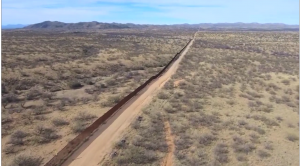By Channing Turner
Cronkite News Service
NOGALES – As a young man, Edward Holler slipped easily through gaps in a U.S.-Mexico border fence behind his house to visit shops and friends on the Mexican side.
Now, reaching the other side can take more than two hours, and Holler said he doesn’t cross more than once every three months.
For almost 100 years, the Holler family homestead has stood just about 50 feet north of the U.S.-Mexico border, and for much of that time members enjoyed the perks of hopping easily across the ribbon of land separating Nogales, Ariz., and Nogales, Sonora.
But life changed during the ’90s, when U.S. Customs and Border Protection replaced a chain-link border fence with a much larger, corrugated-metal fence.
Edward Holler has lived 50 feet from the Mexican border in Nogales, Ariz., for most of his life. Though he used to slip easily through the border fence when he was a child, he says visiting Mexico has become increasingly difficult.
(Cronkite News Service Photo by Channing Turner)
“I couldn’t see Mexico anymore,” he said. “I couldn’t hear the music as well, and I couldn’t see the parades. That’s what I miss.”
Holler’s grandfather built the family’s original stone-and-adobe house in 1912, making it one of the oldest continuously occupied structures in town. When Holler inherited the property, he built a second house on the 8-acre homestead and filled it with relics and treasures that he brings back from Latin America and South America as part of his antique furniture business, Holler and Saunders Ltd. He continues to run the business out of a warehouse on the property.
The fence has grown taller and more imposing over the years. It looms over the property, and strangers loitering near it trigger the arrival of green-and-white Border Patrol vehicles.
U.S. Customs and Border Protection plans to further extend the fence in September, replacing the old landing mat-style fencing with 18-foot concrete bars topped with metal plating, according to Colleen Agle, a spokeswoman for the Border Patrol’s Nogales Sector.
“Newer fencing is taller, stronger – more difficult to cut through – and it is bollard style to grant agents the ability to view potential threats to the south,” Agle said.
Despite the noise and activity that will accompany fence upgrades, Holler said he doesn’t fault the Border Patrol for doing its job.
“The Border Patrol is great with us, and so are the police,” he said. “I’ve never had more protection in my life.”
But added security has drawbacks.
“Now, I have to wait a long time to get back, and it’s not easy [to cross],” he said. “You think about going across, but you don’t.”
Statistics from the past 15 years suggest that Holler isn’t alone. Pedestrian traffic crossing the border peaked at 7,726,045 crossings in 2006 but declined to 4,038,356 in 2009, according to the Bureau of Transportation Statistics.
The number of people crossing by car has steadily dropped to 7,636,384 in 2009 from 11,501,672 in 2000.
Fewer crossings have caused many businesses to leave the area, Holler said, adding that now there is even less incentive to visit the other side.
“The center of Nogales, Sonora, used to be a lot of fun,” he said. “Now it’s not. Things have changed a lot.”
Sam Saunders, Holler’s business partner and housemate for 38 years, said he and Holler were the only ones interested in staying “in this crazy house close to the border.”
“Once, I saw a girl and a guy kissing through the border fence,” Saunders said. “It separates people in dramatic ways.”
Alberto Contreras, who has worked as a restorer at Holler and Saunders for about 20 years, said recent stories of violence and drug trafficking in the area worry him.
“For me, everything is worse,” he said. “It’s bad – the drugs and killings. I hear things, but it hasn’t really affected me, thank God.”
Contreras moved to Nogales from Imuris, Sonora, when he was 10 years old. He said he feels increased hostility in the town since security along the border increased. Mike Diaz, another restorer and native of Nogales, said the fence has become a part of life.
“It’s just there,” he said.
Despite the stories and increased security, Holler said he feels perfectly safe in his home – the only place he said he can imagine calling home.
“I love living here,” he said.





